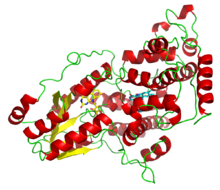光裂合酶
光裂合酶(Photolyases,EC 4.1.99.3)為一種DNA修復酵素,專門修復遭受紫外線破壞的DNA。此酵素的作用需要可見光協助活化[1]及DNA修復[2]。光裂合酶修復DNA的過程稱為光學活作用(photoreactivation)。
| DNA光裂合酶 | |||||||||||
|---|---|---|---|---|---|---|---|---|---|---|---|
 A deazaflavin photolyase from Anacystis nidulans, illustrating the two light-harvesting cofactors: FADH− (yellow) and 8-HDF (cyan). | |||||||||||
| 鑑定 | |||||||||||
| 標誌 | FAD_binding_7 | ||||||||||
| Pfam | PF03441(旧版) | ||||||||||
| InterPro | IPR005101 | ||||||||||
| PROSITE | PDOC00331 | ||||||||||
| SCOP | 1qnf / SUPFAM | ||||||||||
| |||||||||||
由系統發生學來看,光裂合酶是一個相當古老的酵素,從細菌、真菌[3],到動物體內都有[4],且在植物體內尤為重要。人類等胎盤哺乳類體內則並無此酵素活性,而是使用另一種較無效率的核苷酸切除修復法來取代光裂合酶[5]。
DNA中相鄰的胸腺嘧啶受到紫外線的照射時,會形成共價鍵,形成環丁烷橋,稱為胸腺嘧啶二聚體。形成胸腺嘧啶二聚體的基因會導致基因在複製和轉錄時出現錯誤[6]。光裂合酶會接在DNA上,切除胸腺嘧啶二聚體,並修復回原本的樣子。

光裂合酶為一種黄素蛋白,內含兩個捕光性辅因子。所有的光裂合酶都含有FADH−,並可根據他的第二輔因子分為兩類。第一類為葉酸性光裂合酶,其第二輔因子的成分為次甲基四氫葉酸蝶呤(Methenyltetrahydrofolate,MTHF),稱。第二類則為脫氮黃素性光裂合酶,其第二輔因子為8-羥-7,8-二甲基-5-脫氮核黃素(8-hydroxy-7,8-didemethyl-5-deazariboflavin,8-HDF)。FAD本身即有酵素活性,第二輔因子則可在低光狀態下加速反應進行。被光活化的光裂合酶會將FADH−的電子,轉移給胸腺嘧啶二聚體來裂解二聚體[7]。
除了第二輔因子之外,光裂合酶也可根據序列相似性分為兩種,第一種主要在革蘭氏陰性菌、陽性菌、嗜鹽古菌、真菌,和植物體內。Proteins containing this domain also include Arabidopsis thaliana cryptochromes 1 and 2, which are blue light photoreceptors that mediate blue light-induced gene expression and modulation of circadian rhythms.
、可以將光裂合酶分為兩類。The first class contains enzymes from Gram-negative and Gram-positive bacteria, the halophilic archaebacteria Halobacterium halobium,以及真菌與植物。阿拉伯芥的Cryptochrome 1與2亦含有此種結構域,作為促進藍光基因表現與調整昼夜节律的光受體。
The second class are named cryptochrome (Cry), found in species as diverse as Drosophila, Arabidopsis, Synechocystis, and Human (Cry-DASH). These were previously assumed to have no DNA repair activity because of negligible activity on double-stranded DNA. A study[4] by A. Sancar and P. Selby provided evidence to suggest this branch of cryptochromes have photolyase activity with a high degree of specificity for cyclobutane pyrimidine dimers in single-stranded DNA. Their study showed that VcCry1 from Vibrio cholerae, X1Cry from Xenopus laevis, and AtCry3 from Arabidopsis thaliana all had photolyase activity on UV irradiated ssDNA in vitro.
人類體內含光裂合酶之蛋白
- CRY1
- CRY2

